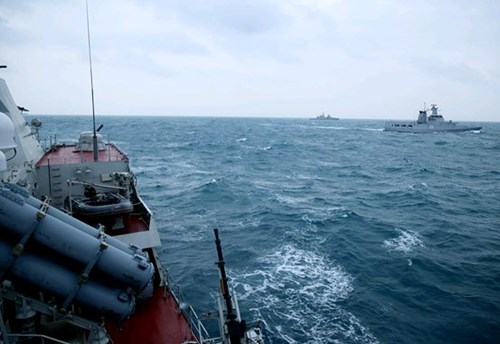Colonel Nguyen Duc Thang, head of the staff officers group on Frigate 015-Tran Hung Dao of the Vietnam People’s Navy participating in the exercise, granted an interview to a reporter of the People’s Army Newspaper.
Reporter: Could you please tell us more about the meaning of the ACMEX-2018?
Colonel Nguyen Duc Thang: As we know, the ACMEX-2018 was held based on the consent between ASEAN member countries and China. The main purpose of the event, which had been underlined since the initial planning conference, was to further boost military exchange and relationship among China and ASEAN member countries in order to maintain their practical cooperation at sea. They worked together in discussing and finalizing assumed scenarios for the exercise, whereby they could find mechanisms to address any incidents and to cooperate in joint search and rescue activities at sea.
In addition, the ACMEX-2018 provided an opportunity for the participants to practice the Code for Unplanned Encounters at Sea (CUES) for naval ships.
The ACMEX-2018 included a staff seminar in Singapore between August 1 and 3, and a field training exercise in Zhanjiang between October 22 and 27.
Reporter: What advantages and disadvantages did the participating delegations encounter at the ACMEX-2018?
Colonel Nguyen Duc Thang: In order to prepare well for the ACMEX-2018, navies of ASEAN member countries and China held three planning conferences: the first in Singapore in May 2018, the mid-term in Zhanjiang in July 2018, and the last in Changi Naval Base in Singapore in August 2018.
There were three advantages. The first one was that the ACMEX-2018 was agreed at the ASEAN-China Informal Defense Ministers' Meeting in February in Singapore. Second, there was a common cooperation trend in the East Sea (or South China Sea). Finally, naval forces of ASEAN member countries and China all wanted to, via naval cooperation at sea, tackle non-traditional threats to maritime security and safety as well as to build a new more effective maritime cooperation to deal with issues of mutual concern.
    |
 |
|
Participating ships in formation at the field training exercise in Zhanjiang |
On the other hand, while joining the ACMEX-2018, each participating delegation had their own purposes and priorities. Hence, the biggest difficulty was how to compromise various interests to unite in achieving the common targets of the exercise. The second was the capacity gap between navies of ASEAN member countries and China, especially when several countries only sent their forces as observers. Besides, the participants faced language barriers, as well as differences in force management and military culture.
Furthermore, it was difficult to set up plans for the field training exercise due to the rough sea season in the designated operational waters. Some ASEAN member countries, although far from China, had not made good additional logistic preparation for long voyages and a complex exercise nor included logistic vessels to their participating missions.
Reporter: How could the ACMEX-2018 open opportunities for future cooperation among ASEAN-China navies?
Colonel Nguyen Duc Thang: The exercise showed that naval ships of ASEAN member countries and China could coordinate well in case of unexpected incidents at sea. Thus, they should further promote delegation exchanges and maintain communication lines at all levels to thoroughly grasp field situations and promptly direct their forces to deal with issues in any circumstances.
At the ACMEX-2018, participating ships successfully conducted coordination at sea. The major contribution to the success of the field drill was the smooth communication among the participants. In addition, the use of CUES made decisive significant contribution to the success of their command, task performance, and coordination among participating vessels at sea. We can affirm that the ACMEX-2018 achieved all set targets.
Reporter: Thank you, Colonel Nguyen Duc Thang!
Reported by Tuan Anh (from Zhanjiang, China)
Translated by Van Hieu